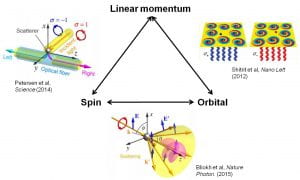Fundamental Acoustics

This research area focuses on the theoretical and experimental study of acoustic wave propagation and wave-mater interaction. In previous research, acoustic metamaterials with properties unprecedented in nature such as negative mass density and bulk modulus were developed to realize desired refractive index distribution and control acoustic wave propagation based on resonance. We have designed parity-time symmetric acoustic device using passive loss and active gain elements, which has been used to demonstrate unidirectional reflection. Based on resonating elements, we have also developed an acoustic metamaterial with simultaneous zero mass density and compressibility, whose refractive index is zero. With this zero refractive index metamaterial, we have collimated cylindrical acoustic wave emitted by a point source into directional plane wave. All of these designs focus on the control of linear momentum of acoustic waves.
In other works, we have generated acoustic vortex beams carrying orbital angular momentum (OAM) using active phase array, which was applied to realize high-speed acoustic communication with multiplexing OAM. An ongoing project focuses on the study of optimal spatial information encoding using the active array. Different acoustic communication techniques are applied to further enhance information capacity and overcome the volume scattering problem in actual ocean environments. We have also observed acoustic spin angular momentum in interfering and evanescent fields. This acoustic spin provides a new control degree of freedom for acoustic wave propagation. An interesting topic focuses on the coupling between the acoustic OAM, spin, and linear momentum as well as the application of these relations on realizing unconventional control of acoustic wave propagation.
Non-Invasive Brain Imaging, Stimulation, and Surgery

Ultrasonic imaging is a major biomedical imaging technique used in clinics. In recent developments, high intensity focused ultrasound (HIFU) was also used in lithotripsy and histotripsy for treatments of kidney stone, tumor, and thrombosis. More recently, low intensity focused ultrasound (LIFU) was used to stimulate brain, whereas HIFU was used for the attempt of non-invasive tremor treatment. Even with the advanced technology, the presence of skull still creates many challenges. The porosity of skull induces a strong acoustic attenuation, resulting in severe heating in the skull when ultrasound propagates through it. Thus, the non-invasive HIFU treatment requires a cooling system around the skull and cannot be used for a long period. The attenuation of high frequency ultrasound is even worse, which limits the high frequency ultrasound to penetrate through skull, and non-invasive ultrasonic brain imaging becomes impossible. The strong impedance mismatch between skull and brain results in a large reflection, further reducing the penetration efficiency of ultrasound through skull. The non-uniformity of skull varies the acoustic phase of transmitted ultrasound, which makes the control of focal point in the brain to be difficult. Indeed, ultrasound can only be focused in a small region of brain, making the non-invasive treatment for diseases located outside the area impossible. This research direction focuses on developing complementary metamaterials with acoustic properties opposite to skull such that the acoustic effect of the skull is suppressed and overcome the aforementioned problems.
Another fundamental limitation of ultrasonic imaging is due to the diffraction limit where the resolution of ultrasonic waves cannot be smaller than their wavelength, typically at millimeter scalar. While the neurons in the brain are normally around 10 microns, the ultrasonic waves cannot visualize the neurons. Current techniques of single neuron imaging requires the histology of the brain so that the neurons can be imaged under optical microscope. These techniques prevent the observation of neuron behaviors in living animals. We are currently developing a super-resolution technique that will allow us to achieve single neuron ultrasonic imaging for both in vitro and in vivo experiments. With this new imaging method, we will be able to observe the neuron behaviors in animals when they are alive under different circumstances.
Cell Manipulation in Microfluidics

Microfluidics are on-chip fluid devices used for medical diagnosis, simulating cell growth environment, and many other biomedical applications. Among these applications, cell focusing, separating, trapping, and pattern were achieved with radiation force of surface acoustic waves (SAW) generated by interdigital transducers (IDT) deposited on piezoelectric substrates. Because acoustic metamaterials have the capability to control the propagation of SAW, the radiation force and torque of SAW are also controllable with these judiciously designed structures. Therefore, we have the ability to control cell translation, rotation, and other motions in microfluidics using acoustic metamaterials. This research direction focuses on designing on-chip metamaterials to realize cell motion control as desired and achieve targeted biomedical functions in microfluidics.
Single Phonon Detector
Phonon as a fundamental boson particle characterize a quantum of vibrational energy in a lattice of atoms. Like photons, phonons have a great application potential in quantum computing and quantum communication. The detection of phonons require highly sensitive devices because of their low energy nature. This research direction focuses on developing highly sensitive devices based on 2D electron gases for single phonon detection and using these devices to study the quantum properties of phonons.

